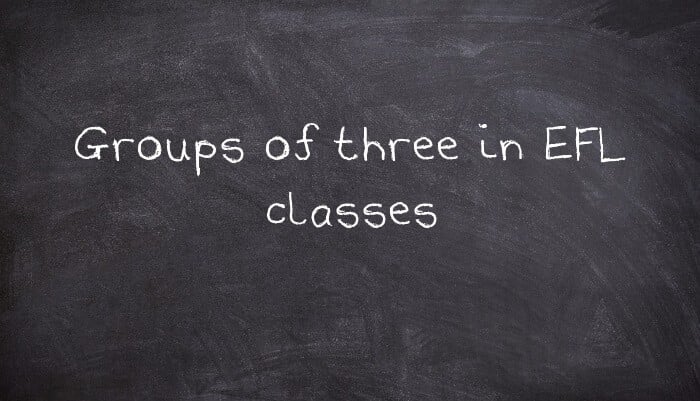Although pairwork is much more famous, putting students into groups of three can be a nice variation which has many advantages, including:
- being a nice change from working in pairs
- being more convenient with nine students or fifteen students
- being more convenient when students are sat three to a table
- no one being paired up just with someone who they don’t want to work with (because that person dominates, barely communicates, etc)
- being good preparation for the bigger challenge of communication in larger groups (perhaps twice as difficult as communicating one to one)
- allowing different kinds of interactions and communication
- allowing some new activities which need three students
This article gives some ideas for great activities which work especially well with three students.
Great three-student activities
If you are teaching telephoning and emailing to your students, you will often find that their main job in real life is to pass such communications onto people with better English and/ or with more decision-making power. It is therefore well worth roleplaying phoning a receptionist to get through to someone else, emailing someone and being passed onto someone else, etc. The former can be made more fun by the receptionist giving different reasons each time why the caller can’t be put through, until they can’t think of any more reasons and so finally connect the caller to the third student.
Many roleplays in non-business situations can also be made more varied, challenging and fun with the addition of a third role, such as a manager who is brought into the conversation when the customer is not satisfied with the answers from a shop assistant or waiter.
Three people is also useful or even vital for more general conversational skills such as interrupting and introducing other people, and starting and ending conversations more generally.
Three is also a good number for roleplaying meetings, with one person whose role is just facilitating communication between the other two, e.g. making sure that they both have an equal chance to speak and trying to help them come to agreement.
You can take this idea of facilitator further and have all communication mediated between the third student, e.g. pretending to be a translator between the other two students (even if both are actually speaking English), or a mediator between two sides who won’t speak directly such as two governments or kidnappers and the police.
There are also useful things a third student can do which don’t involve taking part in the activity, such as listening carefully and giving feedback on things like if the other two students took turns smoothly and if they used the target language correctly. That person can then take part in a second attempt at the speaking activity, with someone else being the note-taker this time. This process can be helped with a worksheet where the third student ticks off the phrases which are used, writes down how long the other two spend on things like small talk, writes down nice language which is used, etc.
In some activities, it can also be useful to have a third student who checks the answers with a dictionary, answer key, etc. For example, if two students are making phrasal verbs from cards with verbs and prepositions, it would interrupt the activity too much for them to stop and check with a dictionary or the teacher each time, so a third student could check what they have done while they move onto their next attempt. While the person with the dictionary might well learn more than the other two, you’ll need to rotate who has this less interesting role.
